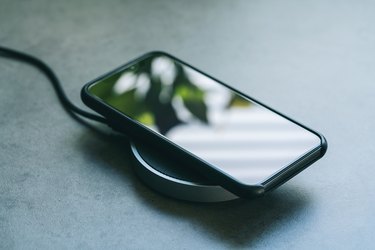
Being stranded without a charger is no fun. Whether you forgot it at home, lost it on vacation or it's suddenly malfunctioned, your first action item will be to find a way to get your battery charged quickly. There are a variety of options, like charging via USB or a hand crank charger, but if you're feeling really ambitious, you can build a charger using a few parts or charge your devices from a power supply.
Charge Spare Battery Without Phone
Video of the Day
The first course of action if you're without your charger should be a USB cable. If you have a computer around or a USB jack in your car, you can charge up your lithium-ion battery quickly and without having to build anything or wait for a special order to arrive. However, if you don't have a USB out jack on the device you need to charge, you may need to resort to other measures.
Video of the Day
Do-it-yourselfers have several options when it comes to charging equipment in a pinch. Whether you need a smartphone, laptop or Sony Handycam charger, with the right materials and some good instructions, you can build a charger that pulls power from existing battery-powered devices like drills.
Charge Battery Using USB Port
At one time, USB cables were for charging mobile devices. However, newer appliances are also coming with USB-charging capabilities. That means instead of having to come up with some sort of DIY option, you can simply grab a USB cable out of your laptop bag and hook it up to any device that charges via USB. If you don't have a USB cable handy, check with the closest electronics store.
But one of the most useful things you can do is turn your existing batteries into a device charger. You can make a homemade drill charger using only some ¼-inch plywood, wood glue, a UBEC DC/DC step-down converter, a USB shell connector, picture hanger hooks, solder, perf board, and a 22k, 20k and 6.2k Ohm resistor. Track down instructions online and you'll have a backup phone charger you can use any time you need it.
Charging Using Alternative Energy Sources
One of the best ways to charge a spare battery without phone chargers, though, is the way that is the most environmentally friendly. You can buy a solar-powered charger for less than $20, but these chargers tend to be bulkier than traditional lithium battery chargers. It may be a better option for something you use less frequently, like as a Sony Handycam charger, than for daily charging of your phone.
Another option that saves energy and gives you a workout is a hand crank charger. These are far bulkier than even a solar-powered charger, though, so you won't find it useful to take on the go. These chargers are typically most handy in the event of a power outage since you can just keep them in your garage or basement and use them as needed.
Charging Battery With Power Supply
If you're a courageous do-it-yourselfer, you can use a power supply to create a homemade drill charger or Sony Handycam charger and charge a spare battery without phone charger. You'll first need to carefully calculate the voltage you'll need based on the number of cells. A lithium-ion battery typically needs 4.20 volts per cell, and your battery will be fully charged once the current drops to 3 percent of the current it's rated to hold.
When you're manually charging a battery this way, it's important to monitor it carefully the entire time. Do not allow your battery to stay on the power supply at the voltage limits for longer than a couple of hours. You can check online to find voltage limits for the specific type of lithium-ion battery you have.